Architecture
 History of the Presidential Office Building
History of the Presidential Office Building
The Presidential Office Building was previously the Office of the Governor-General of Taiwan during the Japanese period. The building was not just a key landmark in that era; its architectural integrity allowed the main structure to survive the Taipei Air Raid of May 1945, despite serious damage to its front left side. After repairs, the building continued to serve as the seat of political power in Taiwan. In 1946, to celebrate the 60th birthday of then-President Chiang Kai-shek, it underwent an extensive renovation and was renamed Chieh Shou Hall ("Chieh Shou" means "Long live Chiang Kai-shek" in Mandarin).

Presidential Office Building today (courtesy of the Department of Special Affairs, Office of the President)

Office of the Governor-General in the Japanese colonial period (reprinted from Taiwan in 1923‧大正12年臺灣事情)
Although the building has been the Presidential Office Building since 1950, it was not until 2006 that its name was officially changed from the "Chieh Shou Hall" to "Presidential Office Building." This change was made to highlight the significance the building carries in constitutional government and to reflect the building's actual use in its name. Beginning from about the 1980s, people in Taiwan started to place greater emphasis upon cultural assets conservation, leading to the passage of a number of laws and regulations in this regard. The Ministry of the Interior in July 1998 made the Presidential Office Building and its neighboring open space a national historical site, with the designation covering the area bounded by Guiyang Street, Baoqing Road, Boai Road, and Chongqing South Road.
The design competition was held in two stages in 1906 and 1907. Seven finalists were selected in the first stage of the contest and these individuals were then provided more time to further flesh out their designs. The second stage of the design contest lasted for one year. The second-stage judging resulted in a surprise. The design by Kichibei Suzuki, which had originally been the favorite, was rejected by the judges as being too similar to the Peace Palace in The Hague. The judges also criticized the drawings as not being refined enough. Ultimately, the official government gazette indicated that there was no first-place winner. The second-place winner was Uheiji Nagano. However, the result of the competition meant that Uheiji Nagano was not qualified to design the Office of the Governor-General, either.
The Presidential Office Building was built during the Japanese colonial period to house the Office of the Governor-General of Taiwan. The history of the Office of the Governor-General can be divided into three periods: 1) temporary headquarters; 2) old Office of the Governor-General; 3) new Office of the Governor-General.
Temporary headquarters
On June 5, 1895, the first Japanese Governor-General of Taiwan, Sukenori Kabayama, set foot on the island in Keelung. He immediately set up a temporary Office of the Governor-General at the customs office in Keelung. The Keelung customs office faced northwest, and consisted of a complex of buildings featuring Western-style architecture. The two-story masonry and wood structures had corridor-style balconies that circled the buildings in a colonial style. These buildings were designed by Western architects and built by locals, just as had also been done in the treaty ports of China and Japan. These buildings had a number of special characteristics: 1) each one of the buildings had broad balconies to provide a shaded place to spend time and also to take shelter from the tropical heat; 2) one could directly walk out onto the balconies from the inside of the buildings; and 3) the ceilings of the balconies were designed to enhance ventilation. After Kabayama moved the seat of government to Taipei, the Keelung customs office ceased to serve as the temporary Office of the Governor-General.
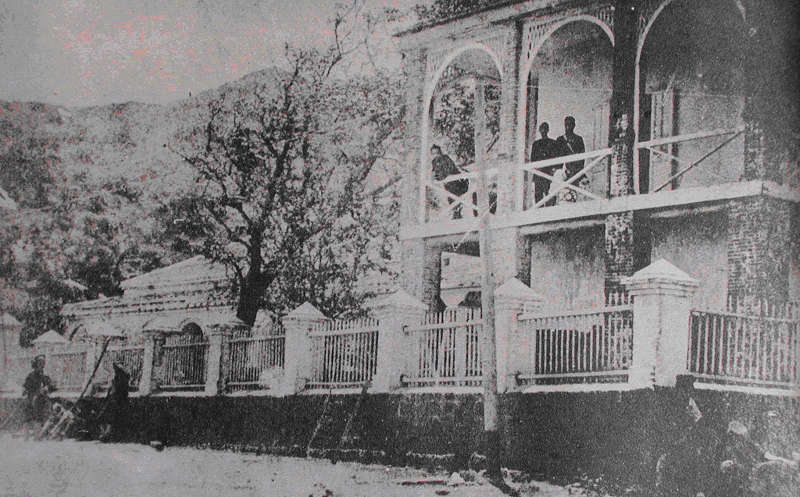
Temporary Office of the Governor-General—the old Keelung customs office (reprinted from Historic Accounts of Prince Kitashirakawa Yoshihisa‧北白川宮能久親王御事蹟)
Old Office of the Governor-General
On June 14, 1895, Governor-General Kabayama moved the seat of government to Taipei and set up temporary headquarters at the former Qing Dynasty Taiwan Provincial Administration Compound, the largest group of official buildings in the city at that time. This served as his temporary headquarters and also provided office space for army staff. The Governor-General's private office and residence were located to the west of the compound. In order to make the entrance more impressive and emphasize the government's authority, the Japanese military had the structures along Ximen Street in front of the building torn down, creating an avenue that went directly to the door of the temporary Office of the Governor-General.
In 1905, a major fire broke out in the structure, causing serious damage to the Office of the Governor-General. The structure was already in poor repair because the colonial authorities had not been doing much to maintain the old government offices of the Qing Court. In addition, the structure had been compromised by termites. Meanwhile, to demonstrate the power of the colonial authorities, the fourth Governor-General of Taiwan, Gentaro Kodama, unveiled a plan to establish a permanent structure to serve as the Office of the Governor-General. The building was completed in 1919, at which time the government offices were moved there.
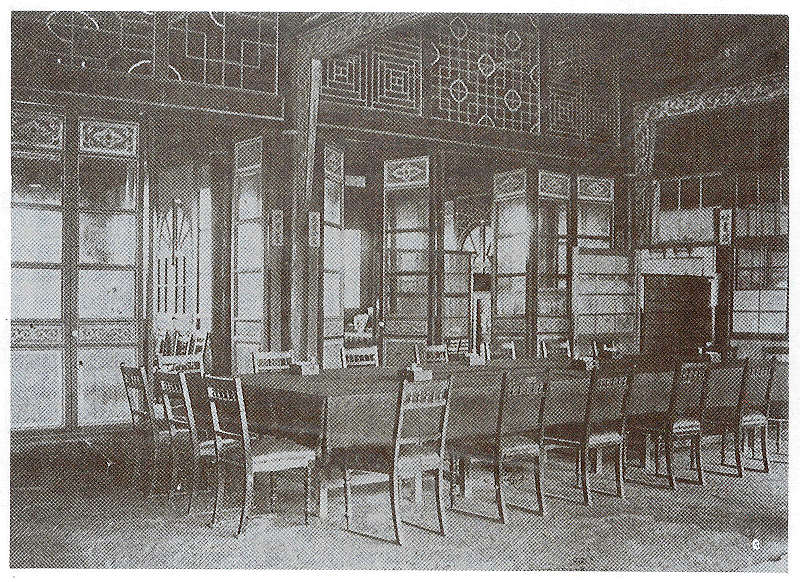
Office of the Logistics and Defense Bureau, which housed the old Office of the Governor-General (reprinted from Portraits of Taiwan‧臺灣寫真帖)
New Office of the Governor-General (current-day Presidential Office Building)
The site for the new building to house the Office of the Governor-General was decided upon the basis of an urban development plan for Taipei City submitted in 1900 by Yoshio Murakami, chairman of the Taipei Urban Planning Commission. The Office of the Governor-General was to be built inside the Taipei city walls near the former Wen and Wu Temples (i.e. temples dedicated to Confucius and General Guanyu, respectively). In addition to a few homes and ponds, two fairly sizeable ancestral halls existed in the vicinity – one for the Lin family and one for the Chen family.
After many rounds of negotiations and surveying, the government appropriated the land and dismantled the structures. The Chen family ancestral hall was moved to the Dadaocheng section of Taipei (and is now known as the Chen Dexing Ancestral Shrine), while the Lin family ancestral hall was moved to an area behind what was then the Taipei railway station. Prior to the construction of the new Office of the Governor-General, the area for a short time served as a horseracing ground and a spot for sports and leisure.
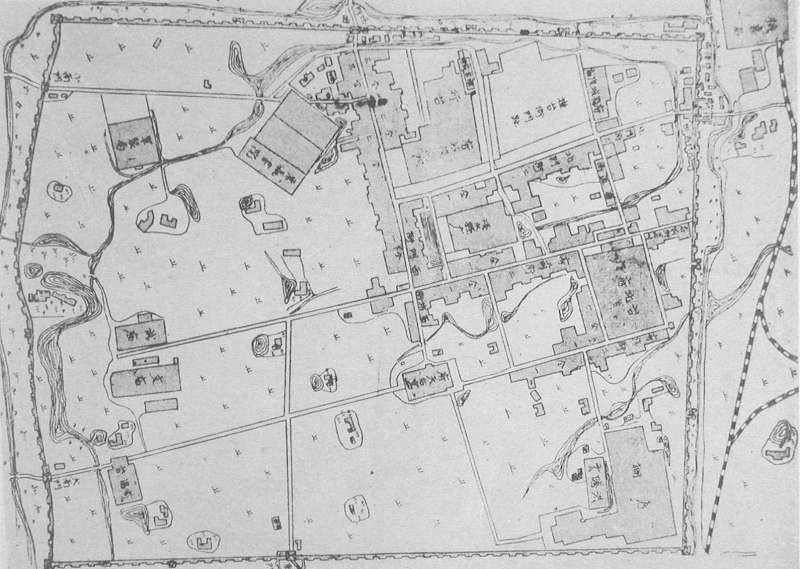
A map of old Taipei drawn during the Japanese colonial period (reprinted from History of Taiwan under Japanese Rule‧臺灣治蹟誌)
An architectural design contest was held to solicit a design for the new headquarters. Shinpei Goto, in charge of civil affairs at the Taiwan Governor's Office during the rule of the fourth governor, came up with the idea of holding the contest. He believed this would not only spur academic progress, but could also involve the entire public and result in the best possible design. The authorities issued announcements in official government gazettes and in local newspapers to inform prospective participants of how and when to submit designs and construction specifications. The final decision on the winner was made by a judging committee, and the design selected by the committee had to be ultimately approved by the Taiwan Governor-General.
The design competition was held in two stages in 1906 and 1907. Seven finalists were selected in the first stage of the contest and these individuals were then provided more time to further flesh out their designs. The second stage of the design contest lasted for one year. The second-stage judging resulted in a surprise. The design by Kichibei Suzuki, which had originally been the favorite, was rejected by the judges as being too similar to the Peace Palace in The Hague. The judges also criticized the drawings as not being refined enough. Ultimately, the official government gazette indicated that there was no first-place winner. The second-place winner was Uheiji Nagano. However, the result of the competition meant that Uheiji Nagano was not qualified to design the Office of the Governor-General, either.
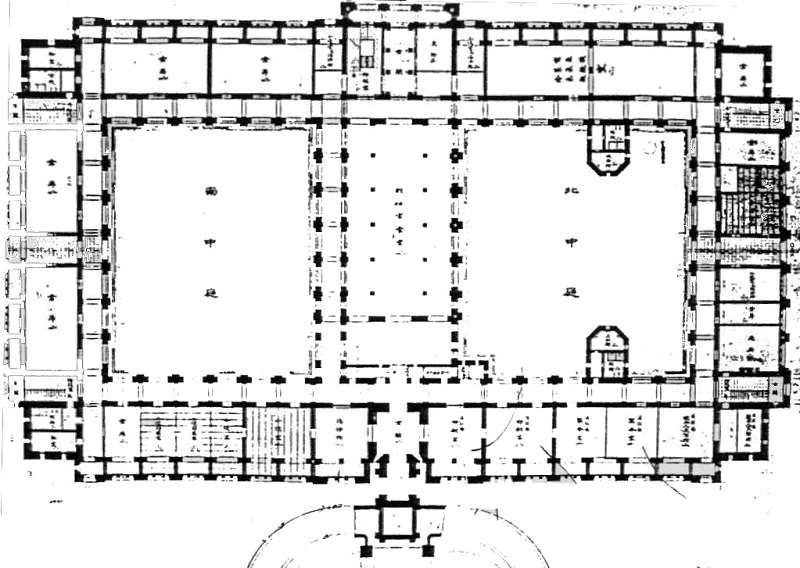
A ground plan for the Office of the Governor-General designed by Uheiji Nagano (courtesy of the office of Huang Chun-ming)
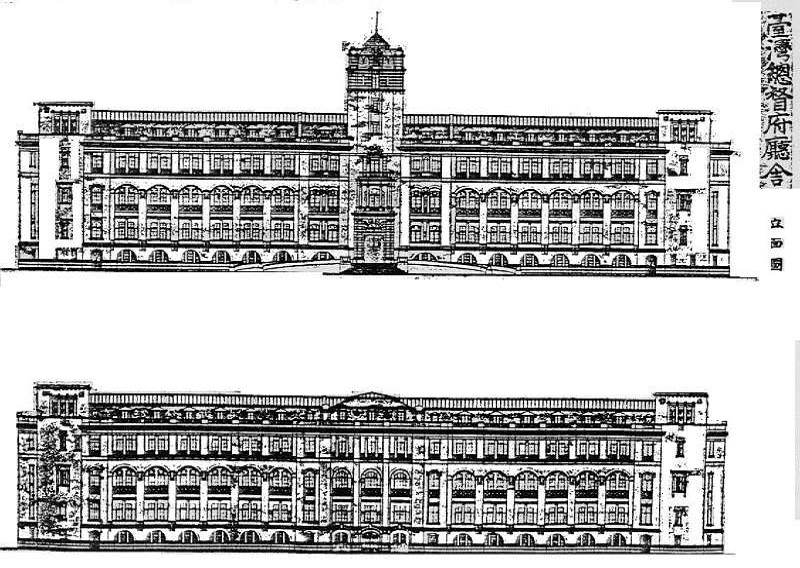
Elevation plans for the Office of the Governor-General as designed by Uheiji Nagano (courtesy of the office of Huang Chun-ming)
The final design of the building was completed by architect Matsunosuke Moriyama. The reason that he was brought in was that no first-place winner was named in the competition and the design of the second-place winner could not be adopted. In addition, a number of other ancillary structures were required in light of various needs. Besides this, the office space as designed by Uheiji Nagano was deemed insufficient.
Matsunosuke Moriyama produced the final design by taking the work of Uheiji Nagano and modifying it. The main difference in Moriyama's design was in the central tower. The original six-story tower as planned by Nagano was heightened to 11 stories to make the building more imposing, thus adding to the symbolism of the building as the center of governing power in Taiwan.
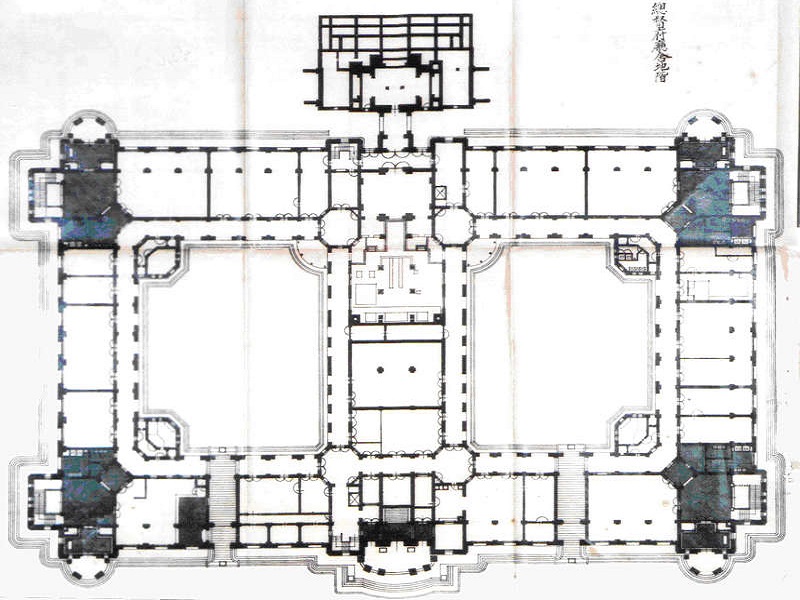
A ground plan designed by Morinosuke Matsuyama (reprinted from Compilation of Documents of the Office of the Governor-General‧臺灣總督府公文類纂)

Front and rear elevation plans designed by Morinosuke Matsuyama (reprinted from Compilation of Documents of the Office of the Governor-General‧臺灣總督府公文類纂)
Construction began on the building in June 1912 with a ground-breaking ceremony. In June 1915, the main structure was completed and a beam-raising ceremony was held. The entire building was completed in March 1919 at a cost of 2.8 million Japanese yen. The first major event to take place at the building was the Taiwan Industrial Exhibition, which was held in 1916 while the structure was still under construction, to mark the 20th anniversary of Japan's colonial administration of Taiwan. The Office of the Governor-General was one of several venues for the Exhibition, which required a temporary office to first be established there. In October and November of 1936, a fair marking the 40th anniversary of Japan's rule over Taiwan was held. A special office was set up at the Office of the Governor-General to engage in related preparatory activities.

An exposition in celebration of the 40th anniversary of Japanese rule in Taiwan took place in this meeting room at the Office of the Governor-General. (reprinted from Exposition for the 40th Anniversary of Japanese Rule in Taiwan‧始政四十周年紀念臺灣博覽會)
![Tablet identifying the building's designer and constructor in the central tower, erected during the beam-raising ceremony [a common practice in Japanese architecture] (courtesy of the office of Shiue Chyn)](/images/aboutus/4-2-1-11.jpg)
Tablet identifying the building's designer and constructor in the central tower, erected during the beam-raising ceremony [a common practice in Japanese architecture] (courtesy of the office of Shiue Chyn)
The new Office of the Governor-General (which today serves as the Presidential Office Building) was five stories tall, with a central tower rising to a height of about 60 meters. At the time, the tower was the tallest structure in Taiwan. Besides the first floor, which contained various service-oriented facilities and offices, floors two through five were used as office space.
Careful consideration was given to the materials used to build the Office of the Governor-General as well as how to transport them to the construction site. The wood used for the roofing and window frames, as well as the quicklime that would be used in the paint for the building's interior, were all sourced mainly in Taiwan. Meanwhile, the red brick covering the exterior of the building and the cement used to create the main structure were mostly imported from Japan or other countries.
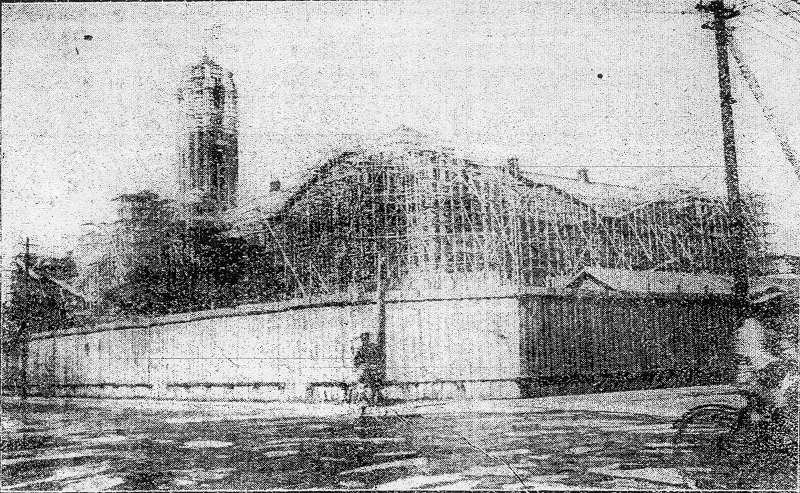
The Office of the Governor-General under construction (reprinted from Taiwan Daily Newspaper‧臺灣日日新報)
A variety of advanced equipment and systems were included in the building's design, including electric power, telephone and telegraph equipment, elevators, a garbage collection system, and a boiler system. Elevators were built in the four corners of the building as well as next to the Main Entrance in front and the Main West Side Entrance in back. In addition, an elevator was built to run between the sixth floor of the building and the top of the central tower. The building was installed with three fireplaces, with one each in the Governor-General's private office, the reception room, and the fourth floor guest room. These three rooms are now the President's Hall, Taiwan Heritage Room, and Rainbow Room, respectively.
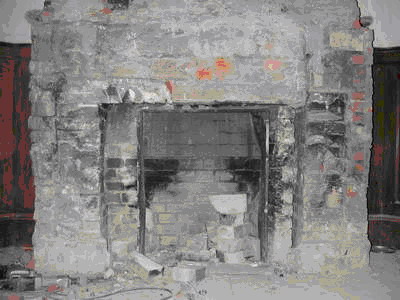
A fireplace in the reception room of the Office of the Governor-General (courtesy of the Office of Shiue Chyn)
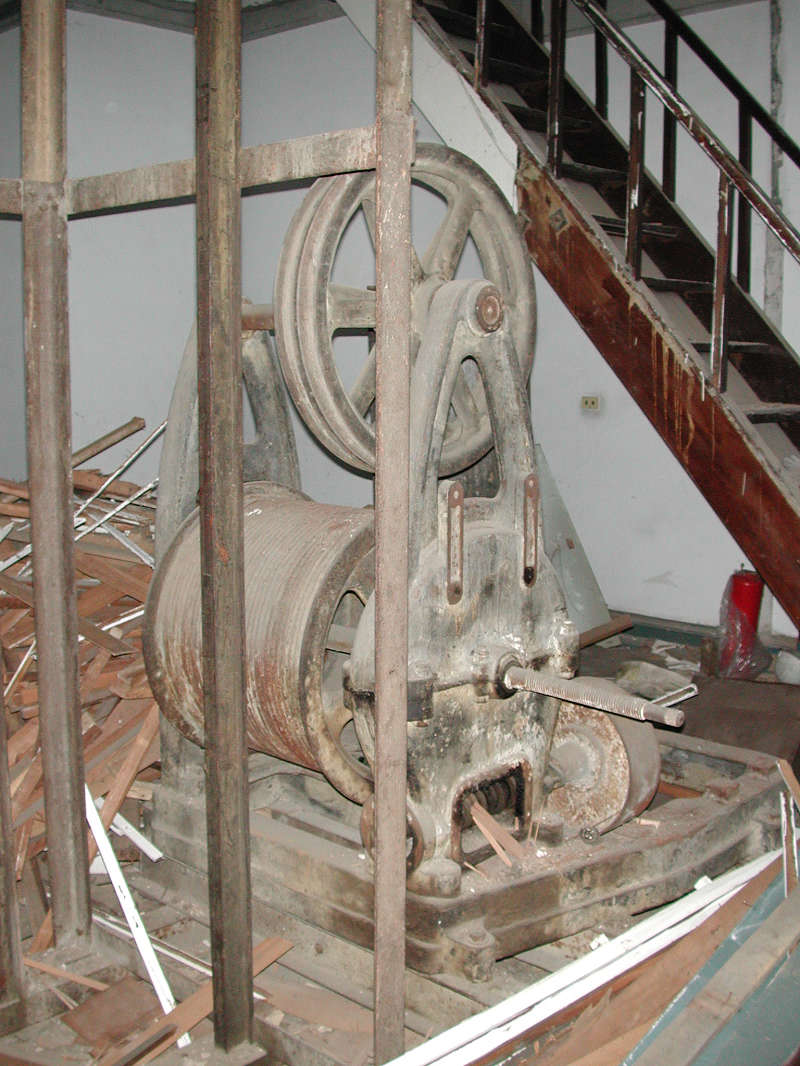
Elevator winch inside the central tower (courtesy of the office of Shiue Chyn)
After the Office of the Governor-General was completed, work continued on a number of ancillary buildings. Off to the south side was a warehouse, while to the east of the warehouse a garage and film screening room were built. These two buildings were linked to the main structure by pedestrian overpasses. After the arrival in Taiwan of the National Government of the Republic of China, a number of other auxiliary structures were added at the north and south ends, including the Li Xing Building, the transportation division, a barracks for military police, and a garage.
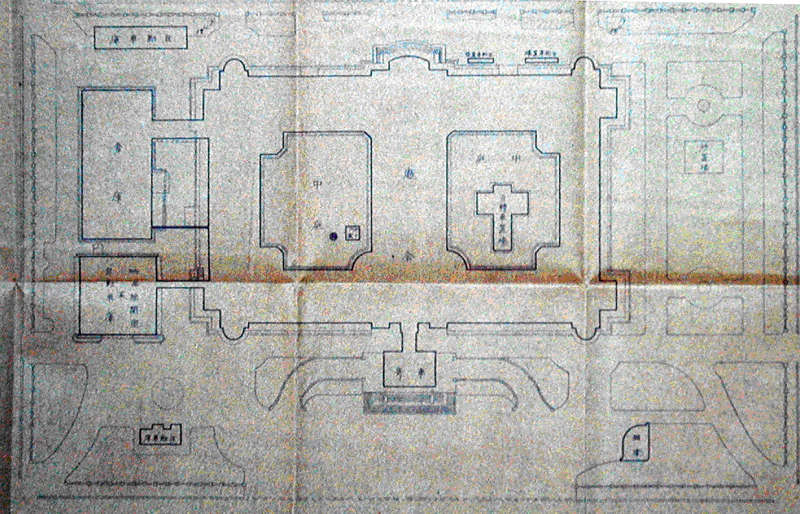
A layout plan for the Office of the Governor-General drawn in the Japanese colonial period (reprinted from Compilation of Documents of the Office of the Governor-General‧臺灣總督府公文類纂)
Attempts were made to camouflage the building during the Second World War to avoid bombing, but the building still took direct hits to the garage on the east side, the central guard tower at the Main Entrance, the elevators and stairwells on the left side of the building, the offices on the southeast side, and the north side of the building across from the Bank of Taiwan. Fires raged in the building for three days.
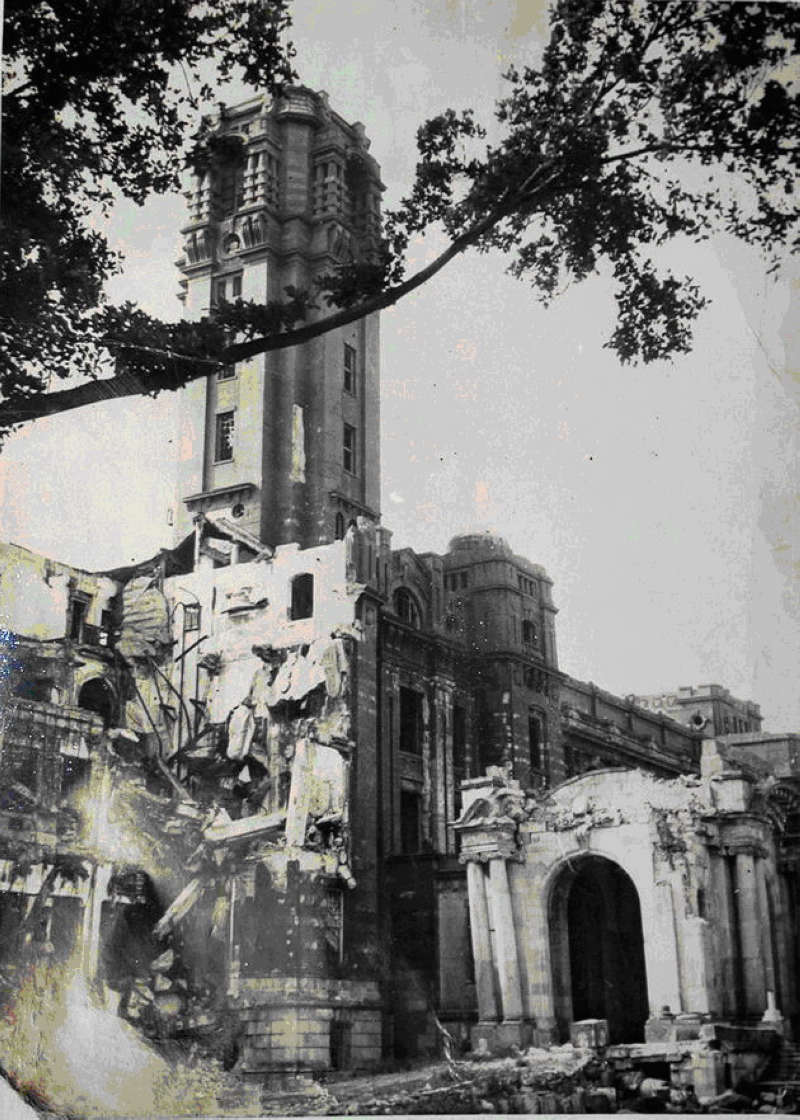
The Office of the Governor-General was damaged in a bombing during World War II. (Photo source: Office of the President)


